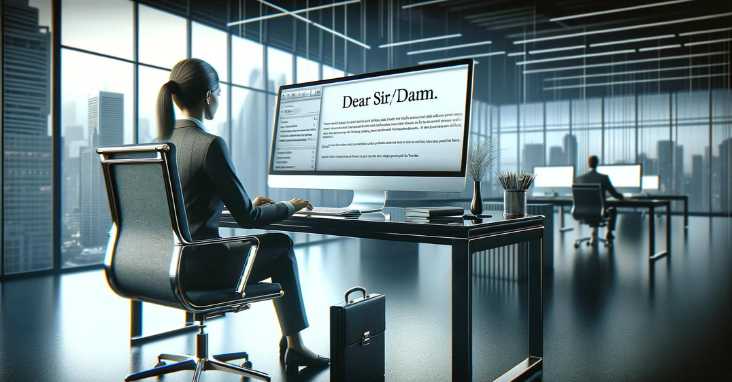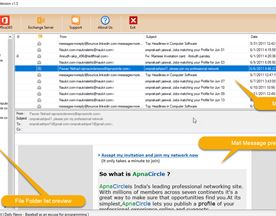The use of salutations in written communication has been a long-standing tradition, but with the evolution of technology and changes in culture, the appropriateness of certain salutations has come into question. One such salutation is “Dear Sir/Madam.” While it may have been the go-to greeting in the past, it is now considered by some to be outdated and even inappropriate in certain contexts.

The origins of “Dear Sir/Madam” can be traced back to formal letter writing, where it was used as a polite and respectful way to address an unknown recipient. However, with the rise of email and more casual forms of communication, the use of “Dear Sir/Madam” has become less common. In fact, some people find it impersonal and even offensive, especially in situations where the recipient’s gender is known.
Despite its declining popularity, “Dear Sir/Madam” still has its place in certain contexts. For example, in formal business correspondence where the recipient’s name and gender are unknown, it may be the most appropriate salutation to use. However, it is important to consider the context and the recipient before using this salutation. Researching the recipient and crafting a personalized opening line can go a long way in establishing a positive tone for the rest of the communication.
Key Takeaways
- “Dear Sir/Madam” is an outdated and sometimes inappropriate salutation in certain contexts.
- It originated from formal letter writing and was used as a way to address an unknown recipient.
- When using “Dear Sir/Madam,” it is important to consider the context and recipient and to personalize the opening line.
The Evolution of Salutations

Historical Context
Salutations have been used for centuries as a way of addressing someone in a formal or informal manner. In ancient times, salutations were used to show respect and honor to individuals of higher social status. In medieval Europe, salutations were used to show respect to nobility and royalty. During this time, salutations were often gender-specific, with different salutations used for men and women.
As society evolved, so did the use of salutations. In the 19th and 20th centuries, salutations became more standardized and formalized. The use of “Dear Sir/Madam” became a common way of addressing someone in a formal letter or email, regardless of gender.
Modern Usage
In today’s society, the use of salutations has become more gender-inclusive. Many people prefer to use gender-neutral salutations such as “Dear Colleague” or “To Whom It May Concern.” This is especially true in professional settings where inclusivity and diversity are highly valued.
Email salutations have also evolved over time. In the early days of email, people would often use informal salutations such as “Hi” or “Hey.” However, as email became more widely used in professional settings, the use of formal salutations such as “Dear” or “Hello” became more common.
In conclusion, the evolution of salutations reflects the changing attitudes and values of society. As society becomes more inclusive and diverse, the use of gender-neutral and inclusive salutations will likely continue to grow in popularity.
Here is a resource with more information on email salutations.
Appropriate Contexts for ‘Dear Sir/Madam’
When it comes to professional correspondence, it’s important to use appropriate language and tone. One common salutation used in formal letters is “Dear Sir/Madam.” However, it’s important to understand when it’s appropriate to use this greeting and when it’s not.
Professional Correspondence
In business letters and other professional correspondence, “Dear Sir/Madam” can be a suitable greeting when the writer does not know the recipient’s name or gender. This is often the case when writing to a company or organization rather than an individual. It is a formal and polite way to address the recipient and can be a good choice for initial contact.
However, if the writer knows the recipient’s name or gender, it’s preferable to use that information instead. Addressing someone by name shows that the writer has taken the time to research and personalize the letter, which can make a positive impression.
Cover Letters
When it comes to cover letters, “Dear Sir/Madam” is generally not the best choice. Instead, the writer should try to find out the name of the person who will be reading the letter and address them directly. This shows that the writer has done their research and is genuinely interested in the position.
If the name of the recipient is not available, the writer can use a more generic greeting such as “Dear Hiring Manager” or “To Whom It May Concern.” However, it’s important to note that these greetings are less personal and may not make as strong of an impression where “Dear Sir/Madam” would fit better.
It’s always important to consider the context and audience when choosing a greeting for professional correspondence. By using appropriate language and tone, the writer can make a positive impression and establish a professional relationship.
For more information on appropriate language and tone in professional correspondence, check out this resource from the Business Writing Blog.
Alternatives to ‘Dear Sir/Madam’
When addressing someone in a formal or professional context, it is important to use the appropriate salutation. While “Dear Sir/Madam” has been a common greeting in the past, it is not always the most appropriate or inclusive option. Here are some alternatives to consider:
Gender-Neutral Options
“Dear Sir/Madam” is not gender-neutral. Using gender-neutral language is increasingly important in today’s society. Here are some salutations that can be used to address someone without assuming their gender:
- “Dear [Company Name] Hiring Manager”
- “To Whom It May Concern”
- “Dear Hiring Team”
- “Dear Recruiter”
Role-Specific Greetings
If you know the recipient’s job title or role, it can be helpful to use a greeting that acknowledges their position. Here are some examples:
- “Dear Marketing Director”
- “Dear Human Resources Manager”
- “Dear Sales Representative”
- “Dear IT Specialist”
Company-Oriented Salutations
If you are addressing someone from a specific company, it can be helpful to use a greeting that acknowledges the company they work for. Here are some examples:
- “Dear [Company Name] Team”
- “Dear [Department Name] Department”
- “Dear Search Committee for [Position Title]”
It is important to remember that the salutation you choose should be appropriate for the context and recipient. If you are unsure of the recipient’s gender or title, it is better to use a gender-neutral or role-specific greeting. Additionally, it is always a good idea to research the company’s culture and values to ensure that your communication is respectful and professional.
For further reading on gender-neutral language, check out this resource from the University of California, Berkeley: Guidelines for Gender-Inclusive Language.
Researching the Recipient

When addressing a letter or email to an unknown recipient, it is essential to conduct thorough research to ensure that the communication is directed to the right person. This section highlights two effective ways of researching the recipient.
Utilizing Online Resources
The internet is a valuable resource for researching people. A simple Google search of the recipient’s full name and email address can reveal a wealth of information, including their job title, company, and social media profiles. It is important to note that not all information found online is accurate or up-to-date. Therefore, it is vital to verify the information gathered using other sources.
One external resource that has high authority on this topic is LinkedIn. LinkedIn is a professional networking platform that allows users to create a profile showcasing their work experience, education, and skills. By searching for the recipient’s name on LinkedIn, one can find their professional profile, which can provide valuable information about their job title, company, and professional network.
Leveraging Professional Networks
Another effective way of researching the recipient is by leveraging professional networks. If the sender has a professional relationship with someone who knows the recipient, they can ask for an introduction or for the recipient’s contact information. This approach is especially useful when the sender is seeking to establish a business relationship with the recipient.
In conclusion, researching the recipient is an essential step in ensuring that the communication is directed to the right person. By utilizing online resources and leveraging professional networks, the sender can gather valuable information about the recipient, which can help them tailor their communication to the recipient’s specific needs and interests.
Crafting the Opening Line

Crafting the opening line of a letter or email can be a daunting task. The first few words can set the tone for the entire message and leave a lasting impression on the reader. In this section, we will discuss the importance of first impressions and grammar and punctuation considerations when writing the opening line.
Importance of First Impressions
First impressions are crucial in any form of communication, especially in business. The opening line of a letter or email is the first thing the reader sees, and it can determine whether they continue reading or not. Therefore, it is essential to put effort into crafting a strong opening line that captures the reader’s attention and sets the tone for the rest of the message.
To write a strong opening line, the writer should consider the purpose of the message and the intended audience. For example, a formal letter to a potential employer should have a different tone than an informal email to a friend. The writer should also consider the context of the message and any relevant cultural or social norms.
Grammar and Punctuation Considerations
In addition to the content of the opening line, the writer should also consider grammar and punctuation. A well-written opening line can be ruined by a misplaced comma or a missing capital letter. Therefore, it is important to pay attention to these details.
The use of a comma or a colon can also affect the tone and meaning of the opening line. For example, “Dear Sir/Madam,” is a formal and respectful greeting, while “Hi,” is more casual and informal. The use of a blank line between the greeting and the body of the message can also affect the appearance and readability of the message.
To ensure that the opening line is grammatically correct and effective, the writer should proofread the message carefully and consider using online grammar tools such as Grammarly. These tools can help identify errors and suggest improvements to the text.
In conclusion, crafting a strong opening line requires careful consideration of the purpose, audience, context, and grammar and punctuation. By putting effort into the opening line, the writer can make a positive first impression and set the tone for a successful communication. For more tips on writing effective opening lines, check out this resource from Inc.com.
Common Mistakes and Red Flags

When addressing someone as “Dear Sir/Madam,” there are certain common mistakes and red flags that should be avoided to ensure a professional and appropriate tone.
Overused Phrases
One of the most common mistakes when using “Dear Sir/Madam” is using overused phrases. These phrases can make the letter sound outdated and lazy. Instead of using clichés, try to personalize the letter and use a more conversational tone.
For example, instead of using “I am writing to inquire about…” try “I wanted to reach out to you to discuss…”. This will make the letter more engaging and attention-grabbing.
Assumptions About the Recipient
Another common mistake is making assumptions about the recipient. This can be inappropriate and may even come across as offensive. Never make assumptions about someone’s gender, age, or occupation based on their name or title.
It’s important to do some research and gather information about the recipient before addressing them. This will help you avoid any red flags and ensure that your letter is appropriate and professional.
When using “Dear Sir/Madam,” it’s important to be mindful of these common mistakes and red flags. By avoiding overused phrases and assumptions about the recipient, you can ensure that your letter is professional and appropriate.
For more information on how to write a professional letter, check out this resource with high authority on the topic.
Closing Salutations
When ending a letter or email, the closing salutation is an important part of the message. It sets the tone for the relationship between the writer and the recipient. In this section, we will explore formal and less formal closing salutations.
Formal Closings
In formal correspondence, it is important to use the appropriate closing salutation. The two most common formal closings are “Yours faithfully” and “Yours sincerely”. “Yours faithfully” is used when the recipient’s name is not known, while “Yours sincerely” is used when the recipient’s name is known.
When using “Yours faithfully”, it is important to ensure that the letter is written in a professional tone. This means avoiding less formal greetings such as “Hi” or “Hey”. Instead, use a more formal greeting such as “Dear Sir/Madam” or “To whom it may concern”.
“Yours sincerely” is used when the recipient’s name is known. This closing is appropriate for formal letters and emails. When using “Yours sincerely”, it is important to maintain a level of professionalism throughout the letter. This includes using proper grammar and avoiding contractions.
Less Formal Alternatives
In less formal correspondence, there are a variety of closing salutations that can be used. These include “Best regards”, “Kind regards”, “Warm regards“, “Cheers”, and “Take care”.
When using a less formal closing, it is important to ensure that the tone of the letter or email matches the closing salutation. For example, “Cheers” might be appropriate for an email between colleagues, but not for a formal letter to a business partner.
It is also important to consider the level of enthusiasm conveyed by the closing salutation. For example, “Best regards” is a neutral closing salutation, while “Warm regards” conveys a greater level of enthusiasm.
To learn more about appropriate closing salutations for different types of correspondence, check out this resource from the Business Writing Blog.
Email Etiquette

When it comes to email communication, it is important to maintain a professional tone and follow proper email etiquette. This section will cover some key points to keep in mind while drafting an email.
Addressing Groups
When addressing a group of people in an email, it is important to use the appropriate salutation. If the group includes people of different genders, it is best to use a gender-neutral salutation such as “Dear all” or “Hello everyone”. It is also important to be clear about the purpose of the email and to avoid using jargon or technical terms that may not be understood by everyone in the group.
Following Up
If you have sent an email and have not received a response within a reasonable amount of time, it is appropriate to send a follow-up email. However, it is important to be polite and professional in the follow-up email. It is also a good idea to include a brief summary of the original email in case the recipient has forgotten about it.
When following up with a colleague, it is important to be respectful of their time and workload. Avoid sending multiple follow-up emails in a short period of time, as this can be seen as pushy or aggressive.
When following up with a recruitment team, prospective employer, or potential client, it is important to express your continued interest in the position or opportunity. However, it is also important to be patient and not come across as too eager or desperate.
Overall, following proper email etiquette can help to ensure clear communication and a positive professional image. For more information on email etiquette, check out this resource from Business Writing Blog.
Cultural Considerations

When addressing someone as “Dear Sir/Madam,” it is important to consider cultural variations and nuances. The following subsections explore some of these considerations.
Global Variations
In some cultures, using formal titles such as “Sir” or “Madam” is considered appropriate, while in others it may come across as overly formal or even disrespectful. For example, in many Asian cultures, using titles such as “Mr.” or “Mrs.” is common, while in some Latin American cultures, it is customary to use first names and even nicknames.
English Language Nuances
In English-speaking countries, using “Dear Sir/Madam” is often seen as a formal and polite way to address someone whose name is unknown or whose gender is unclear. However, it is important to note that in certain contexts, such as business or academic settings, using a person’s name or title may be more appropriate.
When using “Dear Sir/Madam,” it is also important to consider the level of formality required. In some cases, “Dear” may be too formal, and “Hello” or “Hi” may be more appropriate. Additionally, the tone and content of the message should be tailored to the recipient and the context in which it will be received.
For more information on cultural considerations when addressing someone, please refer to this resource.
Frequently Asked Questions

What are appropriate alternatives to ‘Dear Sir/Madam’ in a professional letter?
When addressing someone in a professional letter, it is always best to use a specific name whenever possible. If you do not know the name of the recipient, consider using a gender-neutral salutation such as “Dear Hiring Manager” or “To Whom It May Concern.” Another option is to use the recipient’s job title, such as “Dear Human Resources Director.”
How should I address a cover letter when the recipient’s gender is unknown?
If you are unsure of the recipient’s gender, it is best to use a gender-neutral salutation such as “Dear Hiring Manager” or “To Whom It May Concern.” Avoid using “Dear Sir/Madam” or “Gentlemen” as these are outdated and can be seen as insensitive.
What is the correct way to end a letter that begins with ‘Dear Sir/Madam’?
When ending a letter that begins with “Dear Sir/Madam,” it is best to use a professional closing such as “Sincerely” or “Best regards.” Avoid using overly familiar closings such as “Love” or “Yours truly.”
Can ‘Dear Sir/Madam’ be used as a gender-neutral salutation?
No, “Dear Sir/Madam” is not a gender-neutral salutation as it assumes that the recipient is either male or female. It is best to use a gender-neutral salutation such as “Dear Hiring Manager” or “To Whom It May Concern.”
How can I start a professional email without using ‘Dear’ or ‘Dear Sir/Madam’?
There are several alternatives to using “Dear” or “Dear Sir/Madam” at the beginning of a professional email. Some options include using the recipient’s name, job title, or a gender-neutral salutation such as “Hello” or “Good morning/afternoon/evening.”
What are the best practices for addressing a letter to an unknown recipient?
When addressing a letter to an unknown recipient, it is best to avoid using “Dear Sir/Madam” to use instead a gender-neutral salutation such as “To Whom It May Concern” or “Dear Hiring Manager.” If possible, try to find out the name of the recipient by doing some research or contacting the company directly.
For more information on professional letter writing, check out The Balance Careers, a trusted resource for career advice and guidance.













